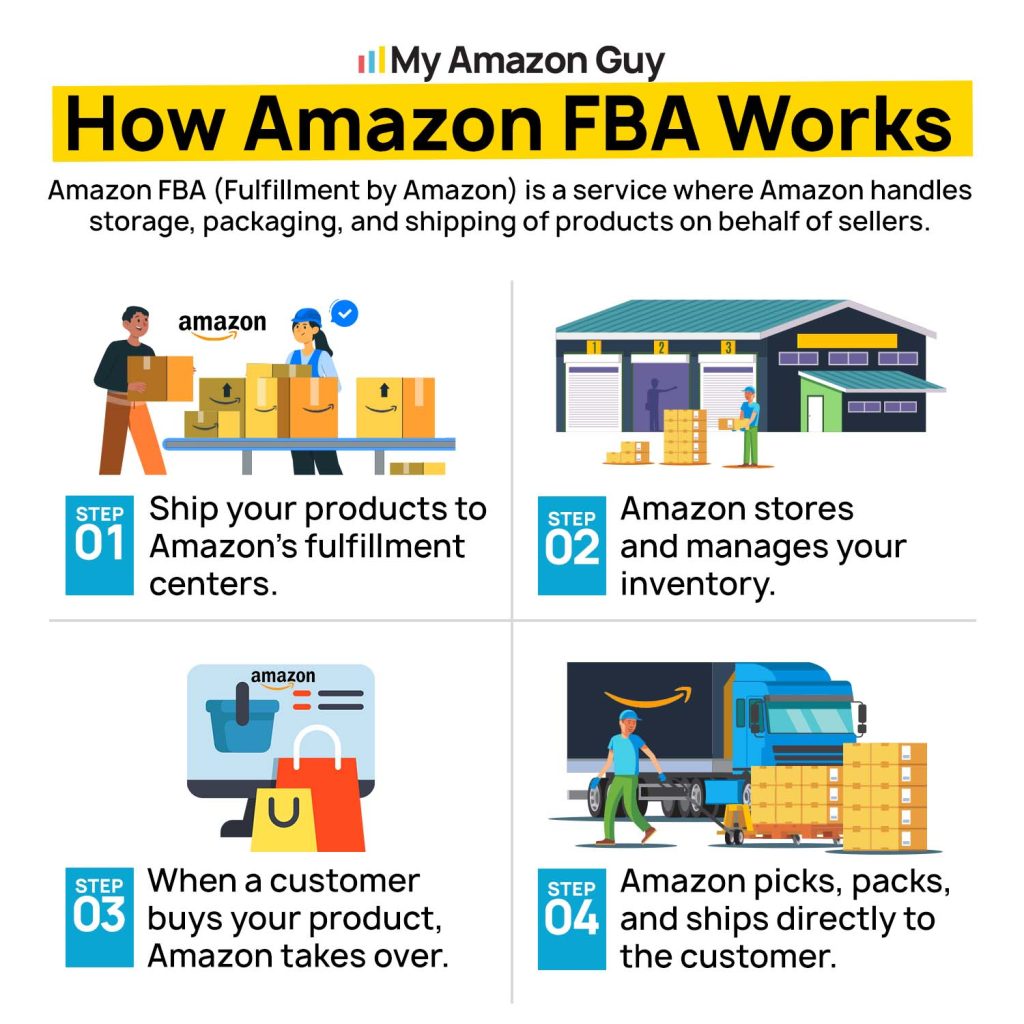Did you know that mismanaging inventory can cost you a lot of money? This is why mastering multi-warehouse coordination is essential for Amazon sellers.
Managing inventory across multiple warehouses can significantly enhance an Amazon seller’s efficiency and customer satisfaction.
Whether you are an FBA (Fulfilled by Amazon) seller or an FBM (Fulfilled by Merchant) seller, understanding how to master multi-warehouse inventory management can lead to faster shipping times, reduced costs, and greater flexibility. However, it also comes with its unique challenges.
This guide tackles the benefits and challenges of multi-warehouse inventory management for FBA and FBM sellers and provides solutions to optimize your strategy.
Benefits of Multi-Warehouse Inventory Management: FBA vs. FBM
The decision to utilize multiple warehouses can significantly impact an Amazon seller’s operations. While both FBA and FBM sellers benefit from this strategy, the specific advantages for seller types vary.
Let’s look into how multi-warehouse inventory management can enhance FBA and FBM sellers’ businesses.
FBA Sellers
1. Faster Shipping Time
Amazon’s Network: Amazon has a vast network of fulfillment centers strategically located across different regions. This network ensures that products are stored closer to where customers are located.
For instance, if a customer in New York orders a product, it’s more likely to be shipped from a nearby fulfillment center, resulting in faster delivery times, often within two days for Prime members.
Automated Allocation: Amazon uses advanced algorithms to optimize where inventory should be placed based on demand patterns. This means that high-demand items are stocked in locations where they are most likely to be ordered, reducing the distance products need to travel.

2. Reduced Shipping Costs
Economies of Scale: Amazon negotiates shipping rates with carriers based on their massive shipping volumes, which typically results in lower shipping costs for FBA sellers. These savings are passed on to sellers using FBA.
Proximity to Customers: Because Amazon places inventory closer to customers, the shipping distances are shorter, which reduces shipping costs.
3. Enhanced Market Reach
Global Reach: Amazon’s fulfillment network spans many countries, allowing FBA sellers to reach international customers easily. Products can be stored in various countries’ fulfillment centers, making international shipping faster and more reliable.
Regional Expertise: Amazon’s expertise in regional logistics ensures that products are delivered seamlessly and reliably across different geographic areas, taking into account local regulations and shipping conditions.
4. Increased Inventory Availability
Demand Forecasting: Amazon’s sophisticated algorithms predict regional demand and distribute inventory accordingly. This means that products are more likely to be available where they are needed, reducing the chances of stockouts.
Automated Replenishment: Amazon’s systems automatically trigger inventory replenishment based on sales trends, ensuring that stock levels are maintained without manual intervention.
5. Flexibility During Peak Seasons
Scalability: Amazon’s fulfillment network can handle significant increases in order volume during peak seasons, such as holidays or sales events. This scalability ensures that FBA sellers can meet customer demand without delays.
Priority Handling: Prime-eligible products benefit from Amazon’s commitment to fast shipping, even during peak times. Amazon prioritizes these products to ensure they are delivered quickly.
Never Run Out of Stock: By effectively managing inventory levels and replenishing stock across multiple warehouses, FBM sellers can ensure they never run out of stock.
This is crucial for maintaining sales momentum, customer satisfaction, and positive seller metrics.
Avoiding stockouts helps to prevent lost sales and reduces the risk of negative impacts on your seller account.
FBM Sellers
1. Faster Shipping Time
Late Shipment Rate: Multi-warehouse inventory management helps lower late shipment rates by reducing shipping distances and improving order routing. Effective inventory management and real-time tracking ensure timely order fulfillment and better account health.
Strategic Placement: FBM sellers have the flexibility to choose their warehouse locations based on where their customers are concentrated. For example, if a large portion of a seller’s customers are in California, they can choose to store more inventory in a warehouse located there, ensuring quicker deliveries.
Direct Control: FBM sellers manage their fulfillment process directly. This control allows them to implement efficient order processing systems, reducing the time it takes to pick, pack, and ship orders.
2. Reduced Shipping Costs
Rate Negotiation: FBM sellers can negotiate their own shipping rates with carriers. By leveraging their shipping volume, they can often secure discounts.
Regional Warehousing: By placing inventory in warehouses that are close to major customer bases, FBM sellers can reduce the distance and cost of shipping, especially for heavy or bulky items that are more expensive to ship over long distances.
3. Enhanced Market Reach
Customizable Network: FBM sellers can set up warehouses in strategic locations based on their specific market needs. For instance, they can place warehouses near urban centers where demand is higher.
Flexible Expansion: As their business grows, FBM sellers can add new warehouse locations to their network, adapting to changing market demands and expanding their market reach.
4. Increased Inventory Availability
Real-Time Tracking: Advanced inventory management systems provide real-time visibility into stock levels across all warehouses. This allows FBM sellers to see exactly how much inventory they have at each location and restock as needed.
Custom Allocation: FBM sellers can allocate inventory based on detailed sales data and market insights. For example, they might stock more of a popular product in a warehouse that serves a high-demand area, ensuring optimal stock levels.
5. Flexibility During Peak Seasons
Adaptive Capacity: FBM sellers can increase their warehouse workforce or partner with third-party logistics providers to handle peak season volumes during the holidays or when there are special events like Prime Day. This flexibility allows them to scale their operations to meet increased demand.
Dynamic Order Management: FBM sellers have the flexibility to adjust their order fulfillment strategies in real-time based on peak season demands and warehouse capacity. For example, they might temporarily prioritize certain high-demand products or reroute orders to less busy warehouses.
Are you prepared for the peak seasons during Q4? Watch this video for essential tips on inventory management, including crucial dates and forecasting strategies.
Key Points
- Timing Matters: Get inventory to Amazon by October 19th for Black Friday.
- Forecasting: Use Amazon tools to predict sales and adjust stock levels.
- Tools: Utilize Amazon’s forecasting features for accurate demand projections.
- Overestimate: Plan for higher inventory to avoid stockouts and capitalize on sales.
Challenges Faced by FBA Sellers Related to Multi-Warehouse Coordination
While multi-warehouse inventory management offers numerous benefits, it also presents a set of unique challenges for FBA sellers. Coordinating inventory across multiple locations requires careful planning and execution to ensure optimal stock levels, cost efficiency, and timely fulfillment.
Here, we will explore the key challenges FBA sellers face in multi-warehouse inventory management and provide practical solutions to address these issues effectively.
1. Inventory Allocation
It can be challenging to ensure the right amount of stock is distributed to each warehouse to meet regional demand without overstocking or understocking.
Solution
- Inventory Placement Service: Use Amazon’s Inventory Placement Service to send all inventory to a single designated fulfillment center. Amazon will then handle redistribution to other centers. This service incurs additional fees but simplifies the initial shipping process.
2. Shipping Costs
Shipping costs can increase due to inventory being spread across multiple locations, especially if products need to be transferred between warehouses.
Solution
- Strategic Stocking: Regularly monitor and adjust inventory levels based on regional demand to minimize the need for inter-warehouse transfers.
- Cost Analysis: Continuously analyze shipping costs and adjust replenishment strategies to balance between shipping costs and delivery speed.
3. Inventory Tracking
Inventory tracking can become complicated as products are stored in different locations, leading to potential errors in stock levels and mismanagement.
Solution
- Advanced Inventory Management Systems: Invest in sophisticated inventory management systems that integrate with Amazon’s logistics to provide better forecasting and replenishment planning, thereby indirectly influencing where inventory may be needed most.
4. Storage Fees
Amazon periodically raises storage fees, which can impact the overall cost of managing inventory across multiple warehouses. Higher fees, especially for long-term storage, can erode profitability and require strategic adjustments.
Solution
- Storage Fee Management: Regularly review storage fees and adjust inventory placement to balance costs. Consider removing slow-moving inventory from high-cost storage locations.
- Fee Optimization Tools: Utilize Amazon’s tools and services to optimize storage costs by keeping track of long-term storage fees and making necessary adjustments.
Amazon’s fees are on the rise again. Check out this video to see how these fee hikes are hitting sellers.
Key Points
- Increased Fees: Amazon is raising fulfillment fees, including new charges for Fulfillment Center (FC) transfers.
- Packaging Issues: Issues with Amazon’s packaging and handling of inventory.
- Frustration with Costs: Rising fees and high low inventory fees are causing dissatisfaction among sellers.
- Customer Support: The unhelpful responses from Amazon’s customer support.
5. Fulfillment Delays
There can be potential delays in order fulfillment if inventory is not properly balanced, leading to longer shipping times for customers.
Solution
- Regular Inventory Audits: Conduct regular audits to ensure inventory is balanced across warehouses based on demand.
- Dynamic Replenishment: Use Amazon’s dynamic inventory replenishment systems to adjust stock levels in response to changing demand patterns.
Challenges Faced by FBM Sellers Related to Multi-Warehouse Coordination
Managing inventory across multiple warehouses is particularly complex for FBM sellers. Unlike FBA, where Amazon handles many logistical aspects, FBM sellers must coordinate every detail of their fulfillment process.
This section will discuss the primary challenges faced by FBM sellers in multi-warehouse inventory management and provide practical solutions to overcome these obstacles.
1. Inventory Allocation
FBM sellers often face challenges in maintaining accurate inventory records across multiple warehouses. Discrepancies in stock levels can lead to overselling or stockouts, negatively impacting customer satisfaction and sales.
Solution
- Centralized Inventory Management System: Implement a centralized inventory management system that can track stock levels in real-time across all warehouses, providing a unified view of inventory.
- Demand Forecasting: Use advanced demand forecasting tools to predict sales trends and allocate inventory more accurately to each warehouse based on regional demand.
2. Order Routing
Sellers might encounter issues in routing orders to the most efficient warehouse for fulfillment. Doing this incorrectly can increase the shipping times and costs so it’s crucial to solve problems like this immediately.
Solution
- Automated Order Routing: Utilize automated order routing software, like ShipStation, that can dynamically assign orders to the nearest or most appropriate warehouse based on inventory levels and customer location.
- Order Management System (OMS): Integrate an OMS that optimizes order routing by considering factors like stock availability, shipping cost, and delivery speed.
3. Inventory Tracking
Keeping accurate track of inventory levels across multiple locations can be difficult for FBM sellers, which can lead to discrepancies and stock management issues.
Solution
- Real-Time Inventory Tracking: Use real-time tracking systems, such as Jungle Scout, to monitor inventory levels across all warehouses, ensuring timely restocking and reducing discrepancies.
- Regular Audits and Cycle Counts: Conduct regular audits and cycle counts to ensure inventory accuracy and quickly identify any discrepancies or issues.
4. Shipping Costs
Shipping costs will increase due to the need to ship products from multiple locations, especially if orders need to be fulfilled from distant warehouses.
Solution
- Regional Warehousing Strategy: Strategically place warehouses in key regions to optimize shipping routes and reduce transit times, thereby lowering shipping costs and improving delivery speed.
- Shipping Rate Optimization: Negotiate shipping rates with carriers based on volume and utilize rate-shopping tools to find the most cost-effective shipping options for each order.
5. Operational Complexity
Managing different warehouses, each with its own processes, staff, and systems, can increase operational complexity and the risk of errors.
Additionally, managing returns across multiple warehouses adds another issue. Each warehouse might handle returns differently, leading to inefficiencies and difficulties in tracking and processing returns accurately.
Solution
- Standardized Procedures: Develop standardized procedures for all warehouses to ensure consistency in operations, reducing the risk of errors.
- Warehouse Management Systems (WMS): Deploy robust WMS that can streamline operations within each warehouse, ensuring efficient receiving, storage, and order-picking processes.
- Return Management Systems: Utilize systems designed to manage returns efficiently across multiple locations, ensuring streamlined processing and accurate tracking.
- Third-Party Logistics (3PL): Partner with third-party logistics providers who specialize in managing multi-warehouse operations, allowing you to leverage their expertise and infrastructure.
Overcoming Multi-Warehouse Inventory Management
Multi-warehouse inventory management enhances efficiency and customer satisfaction for both FBA and FBM sellers, offering benefits like faster shipping and reduced costs. However, it comes with challenges that need careful management.
Addressing these challenges effectively will optimize your inventory management, reduce costs, and boost customer satisfaction.
Need expert advice due to the complexities of multi-warehouse inventory management? Contact our Amazon agency today for personalized support and solutions.





